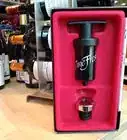wikiHow is a “wiki,” similar to Wikipedia, which means that many of our articles are co-written by multiple authors. To create this article, 13 people, some anonymous, worked to edit and improve it over time.
wikiHow marks an article as reader-approved once it receives enough positive feedback. In this case, 93% of readers who voted found the article helpful, earning it our reader-approved status.
This article has been viewed 113,395 times.
Learn more...
Developed in Burgundy, racking wine is the process of separating new wine from its sediment and moving it from one vessel to another, using simple equipment and gravity. Racking wine is more gentle than using an electric siphon or a pump, which can stir up the sediment. Depending on the kind of wine you're producing, you may need to rack it several times over the course of the fermentation process and immediately afterward. If you want to do the job properly, you can learn how and when to rack your wine to make the job go as smoothly as possible.
Steps
Racking Basics
-
1Get the proper equipment to rack your wine. Racking wine involves using a few relatively simple tools, most of which should come standard with home wine-making kits, or will be available at any home-brewing retailer. To rack wine properly, you'll need:
- At least two carboys or sterilized buckets
- A siphon tube
- An air-lock cap for the wine
-
2Sterilize your siphon tube with meta solution. Commonly called "meta solution," a mixture of potassium metabisulfite or sodium metabisulfite, diluted in water. These are available commercially, or can be mixed at home. In general, about a tablespoon of meta solution needs to be distilled in about a gallon of water.[1]
- Everything that's going to touch the wine needs to be sterilized with meta-solution as well, usually by sloshing a bit of it in the bucket or through the tube, then dumping it in a safe place.[2]
- Meta-solution is pretty harsh, which means it's a good idea to use it in a well-ventilated area, wearing breathing protection and gloves when you're handling it. Follow the directions on the package.
Advertisement -
3Place the wine that you wish to rack on a raised surface. Take the vessel containing the wine with the sediment and open it up, then place it up on a raised surface. Depending on the amount of wine you're making, you may need a significant amount of space to do this, or just a tabletop and the floor of your kitchen. Make sure your siphon tube is long enough to reach wherever you're trying to siphon the wine.
- The process involves gravity, so it's absolutely essential that the full carboy of wine be higher than the tallest portion of the clean receptacle you're going to use to catch the wine, or else the process won't work.
-
4Insert the siphon into the carboy. Place the notched end of the siphon tube into the carboy, making sure to not touch the sediment lying on the bottom. You should be able to see the line of sediment fairly clearly by the time you're ready to rack the wine, and it should be significantly darker and cloudier toward the bottom of the wine. Let the tube fall most of the way into the wine, but keep it at least an inch or two above the sediment line.[3]
- Insert the other end of the siphon into the clean receptacle, or let it hang above. You'll have to get it started and then insert it quickly into the receptacle, but check and make sure the tube is long enough to reach in.
-
5Begin siphoning the wine. There's little science to it: start sucking on the other end of the tube as if you're drinking from a straw until the wine begins to flow, then get the tube into the clean vessel as quickly as possible. This takes a little practice to do without getting a mouthful of wine or spilling. But, hey, a mouthful of wine. It's not the worst.
- When the wine starts going, insert the tube quickly into the receptacle and try to keep the flow “quiet." Keep a close eye on the sediment, making sure you don't stir it up, or that either of the tubes don't splash around, putting lots of oxygen into the wine.
- As second carboy becomes full, or sediment begins to flow, clamp the hose to halt the flow of the wine and cut it off.
-
6Take your losses. Winemaking is an art as much as a science, and you're going to lose some wine in the process. When have you siphoned enough off? You'll mostly be eyeballing it and making the call yourself. It's all part of the job.
- Don't worry about trying to skim right over the top of the sediment and get all the wine possible out and remove all the sediment. If you're making wine yourself, there's going to be a small amount of sediment left at the end.
-
7Cap the newly filled carboy with an airlock. Once you've gotten the wine in the new vessel, install the airlock on top, which should usually be screwed on securely and then clamped down. Different airlocks will work differently, so it's important to follow the specific manufacturer's instructions. Most of them will just need to be plugged directly into the opening in the carboy.
Racking Wine Properly
-
1Rack your wine any time it needs to move. In general, winemakers will use the racking process to rack when moving it from the primary fermenter to the secondary vessel, and when moving wine from the secondary fermenter to a bulk aging vessel. Wine is often also racked after fermentation is complete, to help clarify the wine and remove some of the sediment. The process and vigorousness of racking largely will depend on the variety of wine you're making and your own personal taste as an enjoyer of wine.[4]
- Some wine makers rack only once and others will rack four or five times, depending upon the flavor profile they're going for and how clear they want the wine.[5]
- If you're going to eventually filter your wine, you don't need to rack it more than once or twice.
-
2Do the first racking after 5-7 days. By the time the batch has been fermenting for a week, it'll need to be put into a carboy with an airlock, which means you'll need to move it from the first vessel anyway, making it a good time to rack it and move it to an appropriate secondary fermentation vessel, outfitted with an airlock.
- Be very careful not to rack your wine too early. The fermentation process produces a large quantity of gas, making it dangerous for carboys and barrels alike, if it's too active.
- For the most part, carboys are made safe by outfitting them with an airlock, which serves to let gasses escape the vessel, but keep outside oxygen, microbes, and bacteria from getting in.
-
3Rack when fermentation is completed. The second racking comes when the wine is finished fermenting, sometimes after a few days more and sometimes after as much as a month. Typically, this racking needs to be done to remove as much of the spent yeast as possible, since it should have settled thoroughly and is no longer affecting the fermentation process.[6]
- As the yeast becomes less active a week into the fermentation, it's less vigorous about protecting itself from contaminants, which means it needs to be air-locked. The less sediment that makes it through this first step, the better. Even this early in the process, as much as 80 percent of the sediment will already be in place, as well as lingering pulp from the must.
-
4Rack the wine once more. Most wine is racked no more and no less than three times. The third racking should be completed when the wine is completely cleared up, and this last racking should be done primarily to remove sediment and clarify the wine.
- Some winemakers might choose to rack wine again, if the finished product needs to be very clean and clear to satisfy the style and the variety. Some winemakers will rack several more times to get the clearest wine possible.
- If you're adding sulfites or are planning to filter the wine before you bottle it, you don't need to rack it anymore.
-
5Don't rack every wine. Red wines are traditionally always racked, but some white wines don't need to be and are instead bottled “on the lee,” or sur lie aging. Chardonnay, Champagne, and Muscadet are traditionally bottled on the lee, which some winemakers think helps to alter and integrate the inherent oakiness of the wine.
- If you're making white wine and want to try bottling on the lee, you need to taste the batch often and bottle most of it when it tastes right to avoid spoilage.
-
6Err on the side of fewer rackings. Every time you rack wine, you expose it to lots and lots of oxygen, accelerating the aging process and exposing it to microorganisms and bacteria. Since the sanitization process is a long process prone to human error, it's better to put the wine through fewer racking. Less is more.
Community Q&A
-
QuestionIs it normal to have wine in my airlock?
 Community AnswerNo, it's not normal.
Community AnswerNo, it's not normal. -
QuestionWine is in the first carboy, I get a burp out of the airlock between 5 - 8 minutes. Is that normal?
 Community AnswerThat's carbon dioxide from the fermentation process. The yeast is still working, so that's good.
Community AnswerThat's carbon dioxide from the fermentation process. The yeast is still working, so that's good. -
QuestionThe carboy is not as full as I expected after the first racking. Should the wine be topped off with a similar wine or water to reduce the surface area of the wine in the carboy?
 Community AnswerYou can add sterilized marbles, this will use up some of the airspace left after racking.
Community AnswerYou can add sterilized marbles, this will use up some of the airspace left after racking.
Warnings
- Airlock must be used on carboys or CO2 will build up causing the carboy to explode.⧼thumbs_response⧽
Things You'll Need
- Carboy
- Airlock
- Siphon
- Clamp
References
- ↑ http://www.eckraus.com/wine-making-racking/
- ↑ https://www.baderbrewing.com/content/simplifying-cleaning-and-sanitizing-home-winemakers
- ↑ http://winemakersacademy.com/when-to-rack-wine/
- ↑ http://winemakersacademy.com/racking-lees/
- ↑ http://winemakersacademy.com/racking-lees/
- ↑ http://winemakersacademy.com/when-to-rack-wine/
About This Article
To rack wine, sterilize your siphon tube with meta solution. Next, place the wine on a raised surface and insert one end of the siphon into the carboy, taking care not to touch the sediment on the bottom. Then, insert the other end of the siphon into a clean, empty carboy and let the wine transfer from the old carboy into the new one. Finally, cap the newly filled carboy with an airlock to complete the racking process. For tips on when to rack your wine and how often, read on!

































































